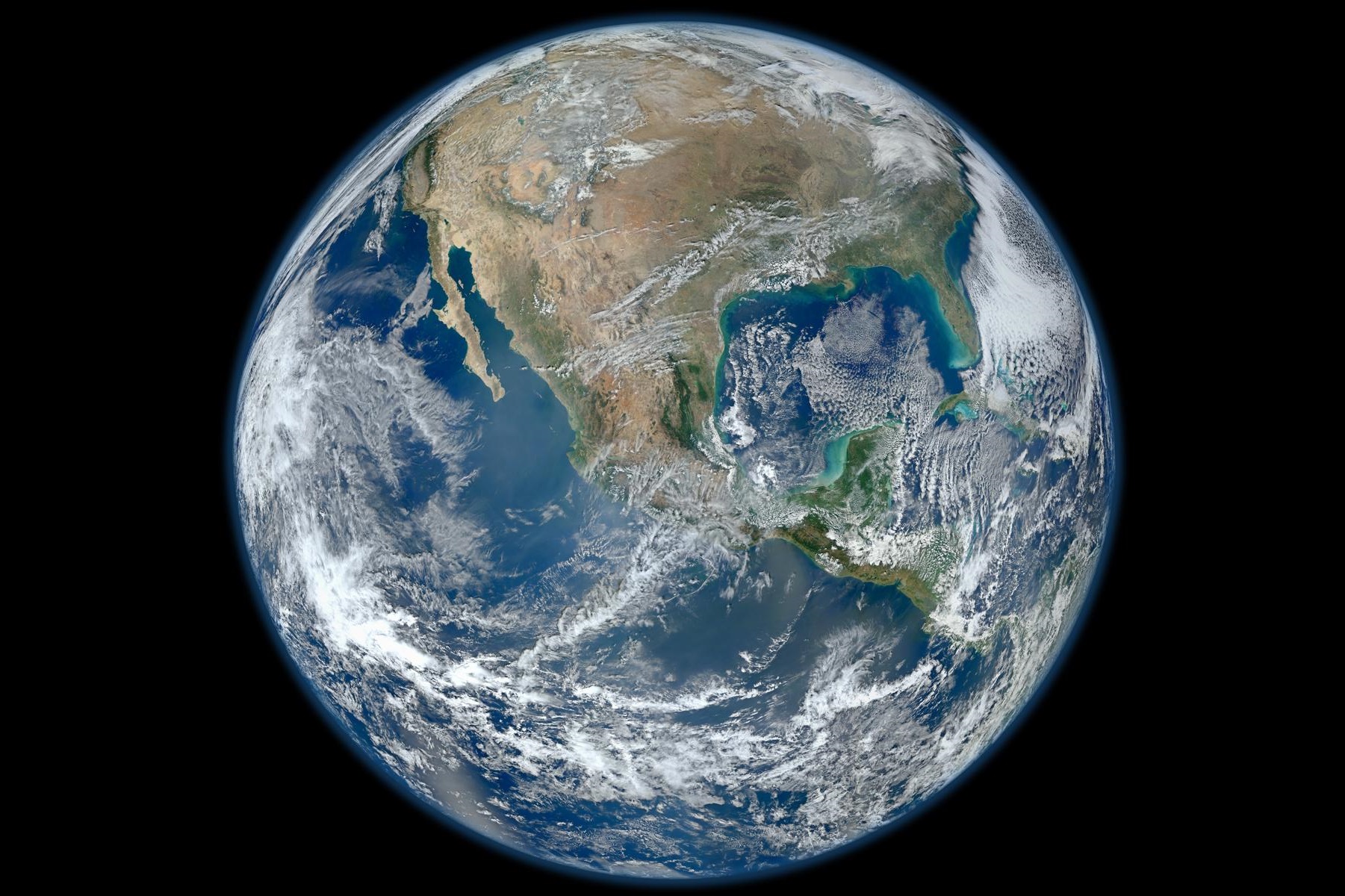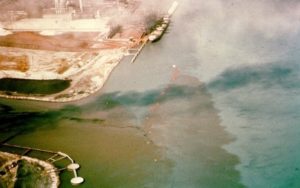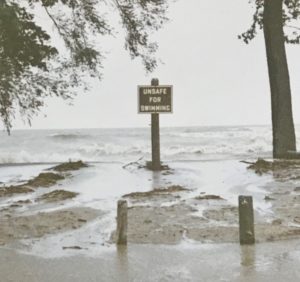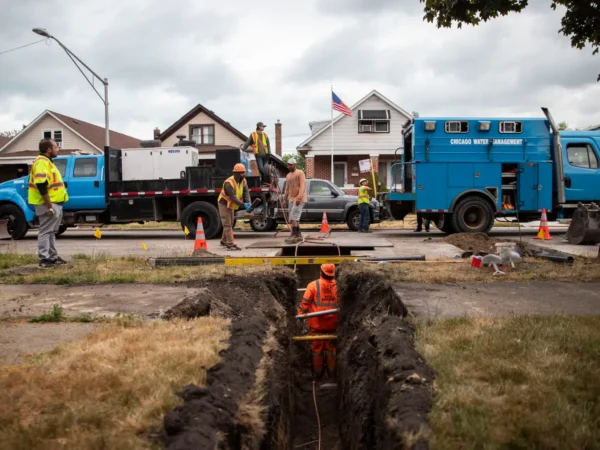
Great Lakes Moment is a monthly column written by Great Lakes Now Contributor John Hartig. Publishing the author’s views and assertions does not represent endorsement by Great Lakes Now or Detroit Public Television.

Oil pollution and raw sewage in the Detroit River, 1960’s, Photo by U.S. Environmental Protection Agency
Growing up in metropolitan Detroit in the 1960s, I vacationed with my family in northern Michigan, hiking trails and exploring the shorelines of the Great Lakes and many inland lakes, looking for much sought-after Petoskey stones, picnicking in state parks, canoeing and fishing, and developing a sense of wonder for the biodiversity and bounty of the Great Lakes.
I so enjoyed those vacations up north and, if you were there, you would have heard me say to my parents, “This is so much fun. Do we really have to go home?”

The beach at Sterling State Park in Monroe, pictured circa 1960s, was closed in the 1960s due to bacterial pollution. Photo courtesy of the Michigan Department of Natural Resources.
At that very same time, my family loved to explore the outdoors near our home in Allen Park, including canoeing, bicycling and picnicking on Belle Isle, shore fishing on the Detroit River, watching the upbound and down bound freighters on the Detroit River, and picnicking and exploring metro parks and Sterling State Park on western Lake Erie.
Our trips to the beach at Sterling State Park were memorable but for the wrong reason. I still vividly remember sitting on beach towels with my family on a beautiful summer day as my parents frowned and told us “Don’t go into the water because it is polluted!” To a young boy these were two polar opposite experiences. Vacations in northern Michigan were in pristine areas. Day trips and weekend excursions near my home were frequently along the Detroit River that was grossly polluted with oil and industrial waste and to Sterling State Park that had signs advising that the water was unsafe for swimming. I questioned:
How can this be? How can one place be so beautiful and unspoiled and the other so polluted? And why don’t people care enough and do something about it?
Burning River
On October 9, 1969, when I was a junior in high school, the Rouge River near my home in Allen Park, Michigan, caught on fire.
I remember coming out of my high school with my friends, seeing black smoke billowing near the industrial complex in southwest Detroit. My friends and I thought that this smoke was likely from a fire at the Ford Rouge Plant or one of the steel plants. When I got home, I learned the true story. The Rouge River caught on fire because of oil pollution. The U.S. Department of Health, Education, and Welfare reported that during the 1960s, Ford’s Rouge Plant was discharging 900 gallons of oil per day, representing 97.5 percent of the oil discharged to the Rouge River.
To some, that might not seem like a lot, but one gallon of oil can pollute a million gallons of water. This means that each day oil was impacting 900 million gallons of water in the Rouge and Detroit rivers.
We soon learned that sparks from an acetylene torch ignited the oil and oil-soaked debris on the river. The Detroit Fire Department reported that flames shot 50 feet in the air and required 10 pieces of fire department equipment and the Detroit Fire Boat—called the John Kendall—to contain the fire. You don’t extinguish a river fire, you contain it and let it burn out.
Three days later, in an Oct. 12 editorial, the Detroit Free Press had this to say about the Rouge River fire:
When you have a river that burns, for crying out loud, you have troubles. It
happened on Cleveland’s Cuyahoga, and now it has happened on the Rouge River.
Other than the Detroit Free Press editorial, there was not much media coverage. There was no national media coverage of the 1969 Rouge River fire, in contrast to the 1969 Cuyahoga River fire. Some duck hunters and fishermen spoke out in opposition, but most people accepted pollution and the river fire as part of the cost of doing business. We were an industrial town and industry provided decent paying jobs.
But my family felt differently. Sitting around the dinner table sharing meals and discussing current events, my parents taught my sister and me that we all have a responsibility for stewardship of the land and water. Indeed, they taught us that we all must do our part to care for natural resources and pass them on as a gift to future generations.
Watch Great Lakes Now‘s segment on the Cuyahoga River fire here:
The First Earth Day

Allen Park High School Earth Day rally on April 22, 1970. Photo by Michael Mouradian
The next year was 1970 and my senior year at Allen Park High School. Throughout the United States, public outcry over pollution was growing. Allen Park High School held one of countless Earth Day rallies on April 22, 1970, where over 20 million Americans demonstrated for clean air and water, and a healthy environment. Hundreds of students participated in our Earth Day rally, with some wearing gas masks. We even buried a paper mache Earth, symbolizing its death.
Starting in the 1920s, autoworkers and other factory workers living in and around Detroit turned to fishing and hunting to counteract their sense of estrangement from the natural world. To support those recreational activities, they joined sportsmen’s clubs. Automobile and other factory workers’ firsthand experiences with water and air pollution put them in the forefront of efforts to control pollution and benefit from outdoor recreational pursuits like fishing and hunting.
The United Auto Workers, under the leadership of President Walter Reuther, helped establish an autoworkers environmental consciousness that led to advocacy to prevent and control pollution. Indeed, it was the UAW’s interest in promoting recreational and leisure activities for its workers and the workers’ growing interest in protecting the environment that led to the development of a working-class environmental consciousness and a labor environmentalism that we all benefit from today. This can be seen in the 1967 statement adopted by the UAW’s International Executive Board:
As we bargain for more time off the job in the form of more paid holidays, longer vacations and early retirement, we must also be concerned that this time can be utilized in the kinds of surroundings that will bring some measure of pleasure, satisfaction and enjoyment to our members and their families. Our Union has demonstrated time and time again that its responsibility to its members does not end with the punching out at the time clock, and that the conservation issue is as vital to us as any we have previously undertaken.

United Auto Workers’ Downriver Anti-Pollution League and the Canadian Auto Workers hold a wake on the Detroit River on the first Earth Day, April 22, 1970. Photo courtesy of the Walter P. Reuther Library at Wayne State University.
One effective initiative organized by the UAW’s Downriver Anti-Pollution League was a U.S.-Canadian wake mourning the death of the Detroit River and Lake Erie on the first Earth Day (April 22, 1970). Boats from both countries met in the middle of the river to hold the wake and place a floral wreath on the murky waters of the Detroit River.
The vice chairperson of the Downriver Anti-Pollution League—referred to in documents from the Walter Reuther Library at WSU only as Mrs. Peter Naccrato—quickly retrieved the wreath from the Detroit River, saying “I don’t want the flowers to get contaminated.”
An April 22, 1970, Earth Day Resolution issued by the Downriver Anti-Pollution League noted:
We, the citizens of Michigan, especially those of us living along the Detroit River, realize that the pollution from American companies along the river affects not only us but our Sisters and Brothers on the Canadian side. We are demanding that our government take more stringent measures against corporations, municipalities, and other sources of pollution.
How Far We Have Come
In the 1960s, the Detroit River was recognized as one of the most polluted rivers in the United States. Oil pollution of the river killed 12,000 and 5,400 waterfowl in 1960 and 1967 respectively.
Detroit’s wastewater treatment plant was only achieving primary treatment (removal of material that would either float or settle out and disinfection) and Detroit’s regional combined storm and sanitary sewer system was discharging over 31 billion gallons of untreated wastewater per year from overflows. Mercury in walleye was three-and-a-half times the standard for safe human consumption. No bald eagles, peregrine falcons or osprey were reproducing in the watershed because of eggshell thinning caused by pesticides like DDT, and no lake sturgeon or lake whitefish were reproducing in the Detroit River. Beaver had long disappeared, and our walleye population was considered in a crisis state.
Today, oil discharges and spills are relatively minor compared to the 1960s and winter duck kills due to oil pollution have been eliminated. Billions of dollars have been spent on upgrading municipal wastewater treatment plants to secondary treatment with phosphorus removal.
Great Lakes Water Authority’s Water Resource Recovery Facility has achieved a more than 90 percent decline in phosphorus discharged to the river down to 0.5 parts per million. Since 1960 there has been a more than 90 percent reduction in untreated combined sewer overflow volume from communities in metropolitan Detroit. We have seen an 80 percent decline in mercury in walleye, yet health advisories remain in effect on certain species and size classes, and we have seen an 88 percent decline in DDE and 90 percent decline in PCBs in herring gull eggs on Fighting Island in the Detroit River. A cleaner ecosystem has led to the return of bald eagles, peregrine falcons, osprey, lake sturgeon, lake whitefish, and even a few beavers, and the Detroit River is now considered part of the “Walleye Capital of the World.”
This represents one of the single most remarkable ecological recovery stories in North America because of where we started with the gross water pollution of the 1960s.
But clearly much remains to be done.
Over 6 million cubic yards of contaminated sediment require remediation along the U.S. shoreline of the Detroit River. Other challenges include rehabilitating and conserving habitats and biodiversity, building green infrastructure to address runoff from our roads, parking lots and rooftops, stopping the introduction of exotic species, and mitigating and adapting to climate change.
As a scientist I worry about societal complacency and the Detroit River reaching another tipping point. But I believe that the progress achieved to date, the broad-based support for a healthy Detroit River, and the advocacy of many environmental and conservation organizations bodes well for its future.
Our Turn to Stand Up
Looking back, the public outcry over pollution of the 1960s and the advocacy of concerned citizens, the UAW and Canadian Auto Workers, conservation clubs, and environmental organizations culminated in the first Earth Day in 1970 that led to an amazing set of legislative accomplishments, including:
- the National Environmental Policy Act of 1970 considered the Magna Carta of environmental laws because more than 100 nations throughout the world have modelled their environmental policies after it;
- the Clean Water Act of 1972;
- the U.S.-Canada Great Lakes Water Quality Agreement of 1972; and
- the Endangered Species Act of 1973.
What an amazing set of accomplishments by people who spoke out for a clean environment in the place they call home.
This month, as we celebrate the 50th anniversary of Earth Day, it is important to remember how far we have come in 50 years, that today we are standing on the shoulders of the environmental giants that spoke out on the first Earth Day, that we have a responsibility to protect and enforce our environmental laws that we benefit from and the previous generation fought so hard to enact, and that we must now do our part to pass on a clean environment and a healthy ecosystem as a gift to future generations.
Great Lakes Now Contributor John Hartig is a board member at the Detroit Riverfront Conservancy. He serves as the Great Lakes Science-Policy Advisor for the International Association for Great Lakes Research and has written numerous books and publications on the environment and the Great Lakes. Hartig also helped create the Detroit River International Refuge, where he worked as the refuge manager until his retirement.
Featured Image: A ‘Blue Marble’ image of the Earth taken from the VIIRS instrument aboard NASA’s most recently launched Earth-observing satellite, Photo by nasa.gov
4 Comments
-
Thank you John Hartig for this thoughtful reflection on the first Earth Day. I remember being in college discussing population growth, sustainability, recycling and our countries urgent need to clean up our environment. Two months later I had a summer job as a deckhand on a Great Lakes freighter. My ship hauled taconite pellets to the East Chicago steel mills. The water in the slip was filthy and the pungent air made breathing difficult, even with a bandanna mask. While progress has been made leaning up our air and water, Earth Day is our annual reminder the challenges we faced in 1970 continue today, and are far from over. Let’s continue the vision of U.S. Senator Gaylord Nelson to educate the youth of the nation so they can help solve our environmental problems.
-
John, it is clear where you get your environmental ethic from…very nice story of your history. I was a freshman in college at SIU in Carbondale, IL and I signed a petition to protect some areas in the Shawnee National Forest as natural areas. I also started my path in recycling and other environmental ventures at that first Earth Day. As you know, I was so lucky to have a 38-year career at EPA where I also got to live out my dream in environmental protection and especially getting to work at GLNPO in my last 10 years. Keep up the good work, pal. I am so glad that we got to work together over the years!!
-
Yes, most definitely. Wouldn’t it be great to have another environmental spring led by young people.
-
Me too John. Thank you for your 38 years of service and I so enjoyed working with you. Keep up you environmental work in IL.




